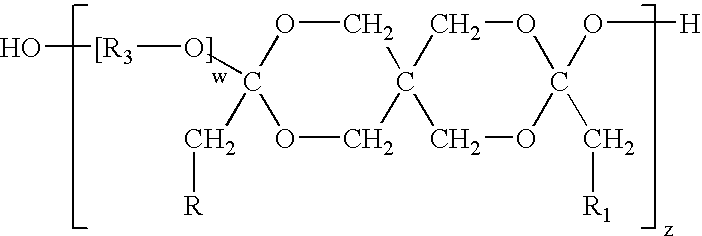Hydrophobic biologically absorbable coatings for drug delivery devices and methods for fabricating the same
- Summary
- Abstract
- Description
- Claims
- Application Information
AI Technical Summary
Problems solved by technology
Method used
Image
Examples
example 1
Synthesis of 3,9-diethylidene-2,48,10-tetraoxaspriro-[5.5]-undecane (DETOSU)
[0053]Diketene acetals can be prepared by several techniques. One method known in the art is the condensation of an appropriate polyhydroxy compound, such as pentaerythritol, with two equivalents of a 2-halocarboxyaldehyde dialkyl acetal, followed by dehydrohalogentaion to yield the diketene acetal. This reaction is described by Corey et al., J. Org. Chem., 38, 3224 (1973).
[0054]Diketene acetals can also be prepared by the isomerization of divinyl acetals. For example, to a 1 liter vessel equipped with a magnetic stirrer, argon inlet and thermocouple, 400 ml of ethylene diamine can be added. The vessel can be immersed in ice water and kept below 4° C. with a steady stream of argon being directed into the flask. A solution containing about 45 g (0.7 moles) of n-butyllithium in hexane can be added to ethylene diamine via gas tight syringe in a syringe pump over one hour. A solution containing about 175 g (0.83...
example 2
Synthesis of Poly(3,9-diethylidene-2,4,8,10-tetraoxaspiro-[5,5]-undecane-co-cyclohexanedimethanol-co-1,6-hexanediol) (DETOSU-CHD-HD)
[0056]A 250 ml, three necked flask can be equipped with a magnetic stirrer, reflux condenser with rubber septum containing an argon inlet, argon outlet, and addition septum. The following reagents can be charged into this flask:[0057](a) about 15 g (0.1042 moles) trans-cyclohexanedimethanol;[0058](b) about 12.29 g (0.1042 moles) 1,6-hexanediol; and[0059](c) about 50 g anhydrous tetrahydrofuran (THF).
[0060]Using a cannula, a solution of about 44.18 g (0.2084 moles) of DETOSU, synthesized as explained in Example 1, in about 50 g of THF can be added to the flask by applying positive argon pressure. About ten drops of a solution of p-toluenesulfonic acid in THF (the concentration can be about 10 mg / ml) can be added and the mixture allowed to stir without heating for one hour. The solution can be slowly poured into 3 liters of methanol containing about 100 p...
example 3
Synthesis of 3,9-dipentylidene-2,4,8,10-tetraoxaspiro[5.5]heptadecane (DPTOSH)
[0061]To a 1 liter vessel equipped with a magnetic stirrer, argon inlet and thermocouple, about 400 ml of ethylene diamine can be added. The vessel can be immersed in ice water and kept below 4° C. with a steady stream of argon into the flask. A solution containing about 45 g (0.7 moles) of n-butyllithium in hexane can be added to ethylene diamine via gas tight syringe in a syringe pump over one hour. A solution containing about 245.7 g (0.83 moles) of 3,9-di(1-pentene)-2,4,8,10-tetraoxaspiro[5.5]heptadecane dissolved in about 170 ml of ethylene diamine can be cooled to about 4° C. and added to the vessel. After agitation at about 4° C. for about four hours, the reaction mixture can be poured onto about 2 liters of ice water with vigorous stirring.
[0062]The resulting solution can be extracted with two 500 ml portions of hexane. The hexane extracts can be combined, and further extracted with three 500 ml po...
PUM
 Login to View More
Login to View More Abstract
Description
Claims
Application Information
 Login to View More
Login to View More - R&D
- Intellectual Property
- Life Sciences
- Materials
- Tech Scout
- Unparalleled Data Quality
- Higher Quality Content
- 60% Fewer Hallucinations
Browse by: Latest US Patents, China's latest patents, Technical Efficacy Thesaurus, Application Domain, Technology Topic, Popular Technical Reports.
© 2025 PatSnap. All rights reserved.Legal|Privacy policy|Modern Slavery Act Transparency Statement|Sitemap|About US| Contact US: help@patsnap.com



